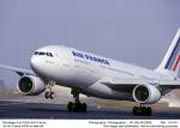 Now that the crash site has been located in mid-Atlantic Ocean, the long hard effort to find out what happened to Air France Flight 447 is under way. Flight crews are surveying the site for debris, and on Wednesday, the Brazilian Navy arrived on the scene. A French ship is en route with a remotely operated submersible aboard. The submersible will first help in the hunt for the pinging sound emitted by the airplane’s flight data and cockpit voice recorders. If the recorders are located, the submersible may be able to retrieve them from as deep as 20,000 feet. Meanwhile, officials have reported that a bomb threat was received by Air France late last month, targeting the Rio de Janeiro-to-Paris route. However, a Brazilian official said the 12-mile-long fuel slick that has been seen on the surface probably would not occur if there had been a fire or explosion. Speculation so far has focused on weather phenomena, including various kinds of icing and turbulence, and possible issues with the Airbus A330’s electronic control systems.
Now that the crash site has been located in mid-Atlantic Ocean, the long hard effort to find out what happened to Air France Flight 447 is under way. Flight crews are surveying the site for debris, and on Wednesday, the Brazilian Navy arrived on the scene. A French ship is en route with a remotely operated submersible aboard. The submersible will first help in the hunt for the pinging sound emitted by the airplane’s flight data and cockpit voice recorders. If the recorders are located, the submersible may be able to retrieve them from as deep as 20,000 feet. Meanwhile, officials have reported that a bomb threat was received by Air France late last month, targeting the Rio de Janeiro-to-Paris route. However, a Brazilian official said the 12-mile-long fuel slick that has been seen on the surface probably would not occur if there had been a fire or explosion. Speculation so far has focused on weather phenomena, including various kinds of icing and turbulence, and possible issues with the Airbus A330’s electronic control systems.
Late Wednesday, the NTSB said it will accept an invitation from French aviation accident investigation authorities to assist in the investigation. Along with an NTSB representative, technical advisors from the FAA, General Electric and Honeywell will assist. Air France said the captain on the flight was 58 years old with 11,000 hours, and the two co-pilots were in their 30s. As the investigation continues, aviators who find the mainstream media unsatisfactory can find more expert updates online. Aviation weather forecaster Tim Vasquez is offering meteorological analysis of the accident at his Web site. Click here for a map of the airplane’s route. Ex-CNN aviation reporter Miles O’Brien features updates and analysis at his blog. The Professional Pilots Rumor Network online forum offers input and opinion from an aviators’ viewpoint. And of course AVweb always keeps you informed.


































